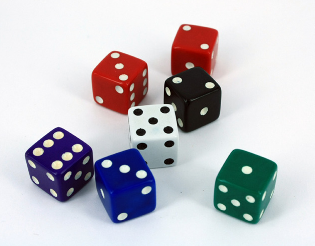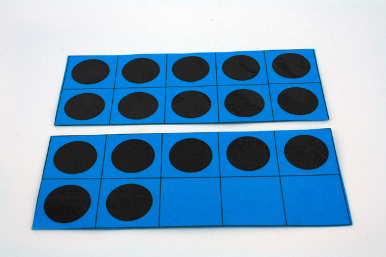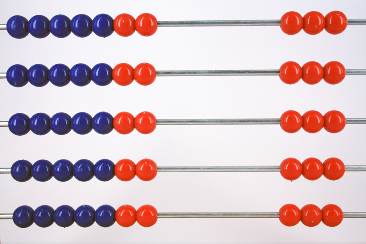Diagnostic questions
Show the student the finger patterns for 4, 9, and 6 and ask the student what numbers they show.
Show the student the numbers 2, 8, and 5 on tens frames and ask the student what numbers they show.
Ask the student to make finger patterns for 3, 7, and 10.
What to notice in the student’s response
Can the student recognise patterns to 5?
Does the student use one-to-one counting for patterns greater than 5?
Can the student recognise and make finger patterns without counting but count the dots when working with a tens frame?
Deliberate acts of teaching
Materials/Links
- Listening tin
- Magnets
- Dominoes and dice
- Abacus
- Tens Frames
- Finger pattern 1–10 cards
- 1–10 digit cards
- Digital Learning Object: Number Trains (Number, level 1)
Recognising and creating patterns is essential for the development of number concepts and relationships.
Familiarise the student with patterns and structures so that the student instantly recognises patterns to 10 when using fingers, tens frames, dice, dominoes, or an abacus. Make connections between pattern representations and work on “five and” grouping patterns.
Listening tin
Ask the student to place their hands behind their back and to close their eyes. Drop magnets into the listening tin and ask the student to use their fingers to make a matching pattern. Ask them to describe their finger pattern and to tell you “how many fingers”. Place the magnets on the tens frame on the front of the tin and compare it to the student’s fingers and to their description.
Connect patterns on tens frame with patterns on other materials
Ask the student to create their own set of numbers on tens frames by drawing pictures or shapes onto blank tens frames. Use the frames to play snap by matching representations of each number with digit cards or with another student’s set of numbers made on tens frames.
Use matching cards (tens frames, finger patterns, dominoes, dice patterns, and digits to 10) to play a matching game or a game of memory.
What to do next if the student is stuck
Give the student opportunities to practise subitising (instantly recognising the number in a small group without counting) by getting them to draw and work with tens frames.
Use an abacus half-covered by card. Move beads out from underneath the card so the student can see them and then move them back again. Point out the change of bead colour when moving from 5 to one more than 5.
Initiating home-based activities
Send home a maths kit that has two sets of tens frames, including blank frames, ten counters, 1–10 dice, a finger pattern set, and cards with numbers 1–10. The student can:
- play memory and snap using tens frames or using a combination of tens frames and finger pattern cards
- roll the dice and, on a blank tens frame, create the number shown on the dice
- match cards showing tens frames, finger patterns, and digits
- use the Digital Learning Object: Number Trains task.
Next teaching steps back in the classroom
Develop the student’s conceptual understanding of teen numbers by practising “ten and” problems.
Introduce addition and subtraction problems that involve making patterns to 10.


